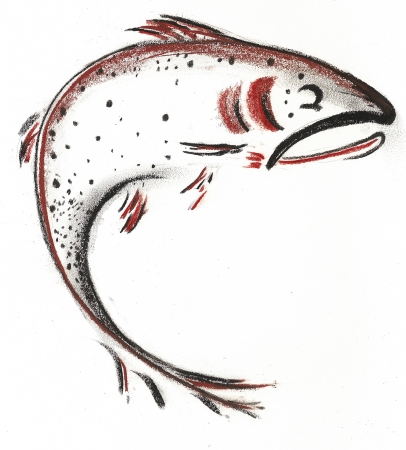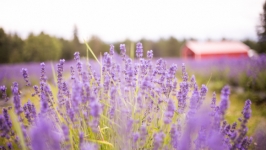Eating Cutthroats
My arm brushed against a tree trunk as I hiked, and I felt movement. A quick glance revealed three-inch-long insects scurrying along the trunk, flies with bright orange stomachs and long antennae. I immediately realized that a good day was about to get much better.
The insects were giant salmonflies, a species of stonefly and the largest species of aquatic insect in Idaho. These insects live as larvae in rivers, then climb out onto rocks to hatch. They return to the water as adults to lay eggs on the surface. Three inches of insect represents considerable protein, and fish gobble them with gusto.
My wife, Jennifer, and I had hiked downstream of Dagger Falls on the Middle Fork of the Salmon River, the gateway to the expansive Frank Church River of No Return Wilderness. And we carried fly rods. We scurried to the river and tied on the largest flies in our boxes.
Jennifer cast first into a deep calm pool in the river. Her fly hit and immediately a fish darted from the depths, slashing the surface. She lifted her rod and hooked a fish, quickly reeling it in. We had recently moved to Idaho, and this was the first cutthroat trout I’d ever seen. With a characteristic orange slash across the bottom of its mouth, bright spots and a deep purplish belly, I found it one of the most striking fish I had ever held.
I cast next and soon was rewarded with a fish of my own. And so the afternoon went. The fish were not large but they rose eagerly to our flies. Meanwhile, salmon leapt up the rapids and an otter cruised by the shallows. Later in the day, we’d see a herd of elk drifting across a Bear Valley meadow and have wolves serenade us as we climbed into our sleeping bags. A perfect day, really.
Only one thing was missing: a couple fish roasted over the open fire.
In the 18 years since then, I have continued to pursue cutthroat trout subspecies across five Western states. Fly fishing for these native fish has become one of my favorite outdoor pursuits. I’m also a lifelong aficionado of wild meat. Bringing a mule deer doe off Idaho’s sagebrush hills is an annual tradition. I’ve eaten the elk and pronghorn, jackrabbit and pigeon. I’ve enjoyed steaks from a springbok I shot in the Namibian plateau, and meatballs made from capybara harvested by Colombian ranchers.
Despite all this, I have never eaten a cutthroat trout.
Understanding why means delving a bit into fish management history—and the state of our fisheries today. Perhaps understanding the history of cutthroat trout can lead us to a better future, one of restoration and protection of the precious wild food we have left.
The American Sportfishing Association estimates that 45 million people in the United States go fishing in any given year, making it one of the most popular forms of outdoor recreation. Fishing is also a food-gathering activity, although in modern times it is easy to forget that.
I recently wrote a book, Fishing Through the Apocalypse, that took a look at the state of our freshwater fisheries through a series of fishing stories. As I fished my way across the country, it struck me how little wild fish I was eating. A meal of wild, native fish has become a relative rarity due to familiar environmental problems like dams, water pollution, habitat loss and overharvest.
It wasn’t always this way. At one point, North American rivers from sea to shining sea were graced with runs of millions of migratory fish, and also contained abundant resident species. Most large rivers in this country contained commercial fisheries: for salmon, shad, sturgeon, even cutthroat trout. And today, that’s largely lost. But we still catch fish, and so we think everything’s rosy.
Cutthroat trout have, in places, faced the same issues plaguing other native freshwater fish, including water quality issues and overfishing. But the biggest factor eliminating cutthroat trout from much of their native range is actually brought on by the short-sightedness of anglers.
As anglers moved their way west, they brought their favorite fish species with them. They stocked rainbow trout that hybridized with cutthroats, brown trout that ate them and brook trout that competed for their habitat. These species now predominate rivers even in states with lots of wild, public land like Idaho. They are the fish celebrated in books like A River Runs Through It. They fuel the guiding and outfitting industry and are featured on calendars and posters. But they’re not the native fish.
Even in Yellowstone Lake in the middle of this country’s first national park, cutthroats have been largely displaced by non-native lake trout. This not only ruined one of the most storied fly fishing destinations in the world, but also impacted the grizzly bears and other wildlife that fed heavily on spawning cutthroat trout.
Cutthroat trout were once one of the most common fish in Rocky Mountain and Pacific Coast rivers. Due to geologic shifts, many cutthroats became isolated and evolved into different lineages. The cutthroats of Pyramid Lake in Nevada historically could reach 25 pounds or more. Cutthroats along the coast make migratory runs much like salmon. A Yellowstone cutthroat looks quite different from one caught in the Frank Church wilderness or in the Colorado River basin.
Due to non-native fish stocking, some of these strains were lost before we really knew what we were losing. Most of the other strains are imperiled. While cutthroat trout still swim in many Idaho waters, most are strictly catch and release. Even in those that permit keeping a fish or two, I could not feel good about eating one.
Unfortunately, most anglers accept the lack of cutthroats as normal. In part, this is due to what ecologists call “shifting baseline syndrome.” Basically, the world we are born into is the world we accept as normal. We no longer know abundant cutthroat runs and wild trout dinners by the fire. Catch-and-release fishing is our normal. Many even consider it noble, not a symptom of loss.
And our lack of native fish is covered up by an expansive hatchery system that dumps thousands of trout into rivers, lakes and ponds each year. These trout are domestic creatures grown on pellets in concrete runs. At one point, conservationists considered hatchery production essential in keeping the fishing tradition alive. Now hatchery-produced fish have become so ubiquitous that anglers consider them normal. But this is not wild food. As the recent Patagonia film Artifishal argues, that hatchery system puts the factory farm model to use for sport fishing.
You wade into a beautiful river, catch some fish and fry them up that evening. Your inner hunter-gatherer might celebrate the meal. But it’s an illusion. You caught a farm animal.
Is there a better way forward? We can begin by protecting the remaining, wild freshwater fisheries we have. Even in wild Idaho, there are surprisingly few. The salmon and steelhead runs are supplemented by hatchery fish and the domestic fish are the only ones you can keep. Sturgeon are imperiled and you can’t even lift one you caught out of the water.
There are bright spots like Bear Lake, straddling the Idaho/Utah border. This isolated lake has two whitefish species and a cisco found nowhere else on earth. And unlike most isolated lakes, these fish have remained abundant, so much so that each year anglers still line the lake to catch them for eating. It’s much easier and more economical to preserve places like this than to restore the fisheries we’ve lost.
But to have a future with cutthroat trout, we’re going to have to undertake elaborate restoration efforts. Anglers may have helped get us into this mess, but now they’re also leading the charge in getting us out. This often involves killing the non-native trout in streams via rotenone, and then restocking with the natives. It’s an extreme measure, but in many waters it’s working. Cutthroat trout are swimming in more streams in the western United States than when I began fishing for them 18 years ago.
Will these fish ever return to numbers where we can eat them over the fire, savoring the memory of the chase as wolves howl in the distance? It’s going to take a lot of time and effort, but we have to try.
I’ll keep on casting flies to them, enjoying their splashy rises—and the wild places they take me. But for now, I’ll forego the cutthroat dinners.






